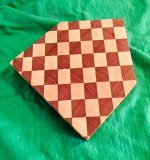GoingMyWay
Member
I finally pulled the trigger and made my first Festool purchase(s). I bought the CT26, TS55, and I had also ordered the ETS 150/5, but it was backordered. I think I may have lucked out that it's backordered. I was originally planning on buying the RO150 until I saw the price so I opted for the cheaper ETS 150/5. After some more research and soul searching, I've come back to my original conclusion that I should buy the RO150. I had always wanted an MFT/3, but thought I'd save my money and instead I made my own tracksaw cutting station using Peter Parfitt's UJK Par Guide Drilling System.
I haven't used the TS55 yet, but I am very impressed with how nice the Systainer is. I have a bunch of various sized Bosch L-Boxxes just for random tool/part/supply storage, and the systainer just feels "nicer" to me. I assembled the CT26 and turned it on to see what it's like. What can I say? It "sucks" - LOL. The suction wasn't as strong as I thought would be, even at full suction. I was pleasantly surprised by how quiet it is. The size of the CT26 is probably bigger than I'd like, but from my research it seems like it's the best all around dust extractor compared to the CT Sys, Midi, or Mini.
I plan on making end grain cutting boards with my new Festool tools. Yes, I know it would be much easier with a table saw, planer, drum sander, and who knows what other tools, but I am hellbent on making an end grain cutting board using only a CT26, TS55, RO150, and my homemade tracksaw cutting station.
-David
I haven't used the TS55 yet, but I am very impressed with how nice the Systainer is. I have a bunch of various sized Bosch L-Boxxes just for random tool/part/supply storage, and the systainer just feels "nicer" to me. I assembled the CT26 and turned it on to see what it's like. What can I say? It "sucks" - LOL. The suction wasn't as strong as I thought would be, even at full suction. I was pleasantly surprised by how quiet it is. The size of the CT26 is probably bigger than I'd like, but from my research it seems like it's the best all around dust extractor compared to the CT Sys, Midi, or Mini.
I plan on making end grain cutting boards with my new Festool tools. Yes, I know it would be much easier with a table saw, planer, drum sander, and who knows what other tools, but I am hellbent on making an end grain cutting board using only a CT26, TS55, RO150, and my homemade tracksaw cutting station.
-David

